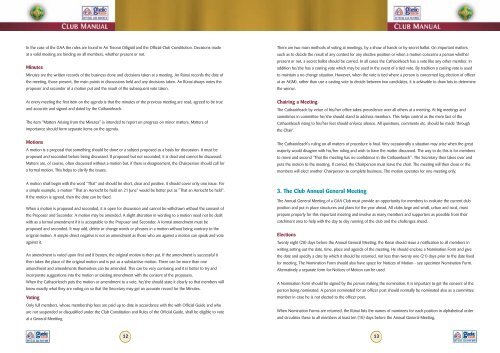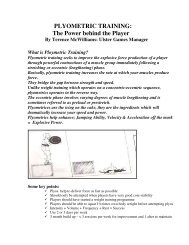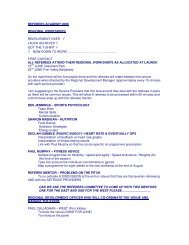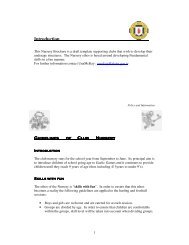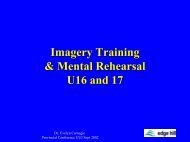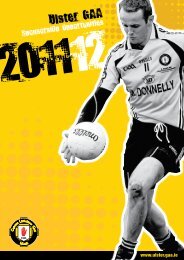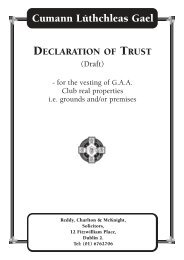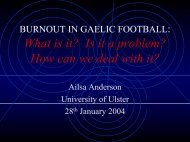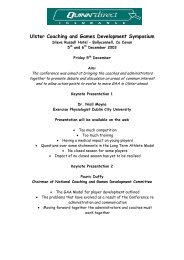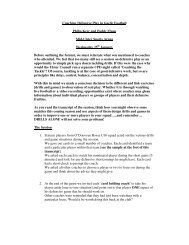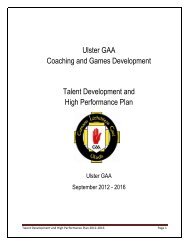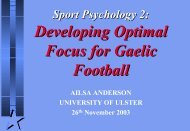Club Manual - Ulster GAA
Club Manual - Ulster GAA
Club Manual - Ulster GAA
Create successful ePaper yourself
Turn your PDF publications into a flip-book with our unique Google optimized e-Paper software.
In the case of the <strong>GAA</strong> the rules are found in An Treorai Oifigiúil and the Official <strong>Club</strong> Constitution. Decisions made<br />
at a valid meeting are binding on all members, whether present or not.<br />
Minutes<br />
Minutes are the written records of the business done and decisions taken at a meeting. An Rúnaí records the date of<br />
the meeting, those present, the main points in discussions held and any decisions taken. An Rúnaí always notes the<br />
proposer and seconder of a motion put and the result of the subsequent vote taken.<br />
At every meeting the first item on the agenda is that the minutes of the previous meeting are read, agreed to be true<br />
and accurate and signed and dated by the Cathaoirleach.<br />
The item "Matters Arising from the Minutes" is intended to report on progress on minor matters. Matters of<br />
importance should form separate items on the agenda.<br />
Motions<br />
A motion is a proposal that something should be done or a subject proposed as a basis for discussion. It must be<br />
proposed and seconded before being discussed. If proposed but not seconded, it is dead and cannot be discussed.<br />
Matters are, of course, often discussed without a motion but, if there is disagreement, the Chairperson should call for<br />
a formal motion. This helps to clarify the issues.<br />
There are two main methods of voting at meetings, by a show of hands or by secret ballot. On important matters<br />
such as to decide the result of any contest for any elective position or when a motion concerns a person whether<br />
present or not, a secret ballot should be carried. In all cases the Cathaoirleach has a vote like any other member. In<br />
addition he/she has a casting vote which may be used in the event of a tied vote. By tradition a casting vote is used<br />
to maintain a no change situation. However, when the vote is tied where a person is concerned (eg election of officer<br />
at an AGM), rather than use a casting vote to decide between two candidates, it is advisable to draw lots to determine<br />
the winner.<br />
Chairing a Meeting<br />
The Cathaoirleach by virtue of his/her office takes precedence over all others at a meeting. At big meetings and<br />
sometimes in committee he/she should stand to address members. This helps control as the mere fact of the<br />
Cathaoirleach rising to his/her feet should enforce silence. All questions, comments etc. should be made 'through<br />
the Chair'.<br />
The Cathaoirleach's ruling on all matters of procedure is final. Very occasionally a situation may arise when the great<br />
majority would disagree with his/her ruling and wish to have the matter discussed. The way to do this is for members<br />
to move and second "That the meeting has no confidence in the Cathaoirleach". The Secretary then takes over and<br />
puts the motion to the meeting. If carried, the Chairperson must leave the chair. The meeting will then close or the<br />
members will elect another Chairperson to complete business. The motion operates for one meeting only.<br />
A motion shall begin with the word "That" and should be short, clear and positive. it should cover only one issue. For<br />
a simple example, a motion "That an Aeríocht be held on 21 June" would be better put as "That an Aeríocht be held".<br />
If the motion is agreed, then the date can be fixed.<br />
When a motion is proposed and seconded, it is open for discussion and cannot be withdrawn without the consent of<br />
the Proposer and Seconder. A motion may be amended. A slight alteration in wording to a motion need not be dealt<br />
with as a formal amendment if it is acceptable to the Proposer and Seconder. A formal amendment must be<br />
proposed and seconded. It may add, delete or change words or phrases in a motion without being contrary to the<br />
original motion. A simple direct negative is not an amendment as those who are against a motion can speak and vote<br />
against it.<br />
An amendment is voted upon first and if beaten, the original motion is then put. If the amendment is successful it<br />
then takes the place of the original motion and is put as a substantive motion. There can be more than one<br />
amendment and amendments themselves can be amended. This can be very confusing and it is better to try and<br />
incorporate suggestions into the motion or existing amendment with the consent of the proposers.<br />
When the Cathaoirleach puts the motion or amendment to a vote, he/she should state it clearly so that members will<br />
know exactly what they are voting on so that the Secretary may get an accurate record for the Minutes.<br />
Voting<br />
Only full members, whose membership fees are paid up to date in accordance with the with Official Guide and who<br />
are not suspended or disqualified under the <strong>Club</strong> Constitution and Rules of the Official Guide, shall be eligible to vote<br />
at a General Meetting<br />
3. The <strong>Club</strong> Annual General Meeting<br />
The Annual General Meeting of a <strong>GAA</strong> <strong>Club</strong> must provide an opportunity for members to evaluate the current club<br />
position and put in place structures and plans for the year ahead. All clubs large and small, urban and rural, must<br />
prepare properly for this important meeting and involve as many members and supporters as possible from their<br />
catchment area to help with the day to day running of the club and the challenges ahead.<br />
Elections<br />
Twenty eight (28) days before the Annual General Meeting, the Rúnaí should issue a notification to all members in<br />
writing setting out the date, time, place and agenda of the meeting. He should enclose a Nomination Form and give<br />
the date and specify a date by which it should be returned, not less than twenty one (21) days prior to the date fixed<br />
for meeting. The Nomination Form should also have space for Notices of Motion - see specimen Nomination Form.<br />
Alternatively a separate form for Notices of Motion can be used.<br />
A Nomination Form should be signed by the person making the nomination. It is important to get the consent of the<br />
person being nominated. A person nominated for an officer post should normally be nominated also as a committee<br />
member in case he is not elected to the officer post.<br />
When Nomination Forms are returned, the Rúnaí lists the names of nominees for each position in alphabetical order<br />
and circulates these to all members at least ten (10) days before the Annual General Meeting.<br />
12<br />
13


